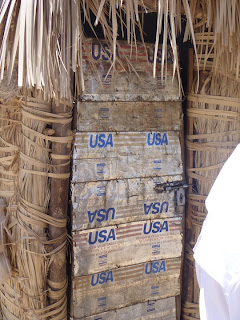 |
| Note the curled mustache |
 |
| A giant praying mantis that appeared after a rain storm |
Halloween is here, the sun is shining, and you couldn't find a trick-or-treater for hundreds of kilometers. Hearing of the snow in New York, I'm starting to dread the return journey. I've gotten used to the constant sun and over-100 degree weather. Living here has also caused some serious changes in my mentality. I no longer think of texting, see any advertisements, I have very little idea of what's going on with the news, and I don't even keep track of the time of day. When I see people outside of the compound, I smile and wave and say "Ejoka", which is Turkana for hello (I think). Now I no longer find it strange that they are baffled by our skin, our hair, and our digital cameras. I also don't mind the bugs anymore! But I'm getting ahead of myself.
This week we started our unit on Human Evolution. Before taking this module, I thought of myself as being fairly knowledgeable about human ancestors and human evolution. I had the impression that we had most of the kinks in our family tree worked out and this evidence was being taught to us as a fait accompli. But I was completely wrong.
 |
| A complete cast of the famous Lucy fossils for us to examine |
Hearing our professor, Bernard Wood, discuss the fossil record I was struck by the extremely limited extent of our knowledge. Within the scientific community, virtually nothing is agreed upon. With very early fossils, it is sometimes unclear whether they represent hominins (the family we belong to) or merely fossil apes. And with the slightly later fossils (around Lucy's age), researchers argue about whether certain fossils represent distinct species, or if they can be lumped together in the same category. Even the extent of our genus Homo hasn't been decided upon.
The problem mainly boils down to a lack of evidence. Bones are the only thing that are normally preserved, and while we can tell quite a bit from bones, reconstructing evolutionary relationships from them can be, in the words of our professor, "a bit dodgy". Even the bones we do get are mangled and distorted most of the time, which adds another layer of difficulty.
 |
| An evolutionary tree of all living primates |
 |
| A modern human skeleton |
But apart from engaging in the intellectual battle of scientific uncertainty, we also had a bit of fun this week. On Saturday we decided to throw our own little Halloween party. We had very little resources to work with for our costumes, but some of us got on quite well.
 |
| My classmate, Hui, dressed as a Zebra. I call it a Huibra |
The next day, we painted a newly built medical dispensary. TBI and affiliated organizations help build these dispensaries and give them enough supplies to help the people living in the area, who have little else to turn to.
Another great week in the Turkana Basin. Now go out and enjoy your Halloween candy!
 | ||||||
| Cheers! |





































